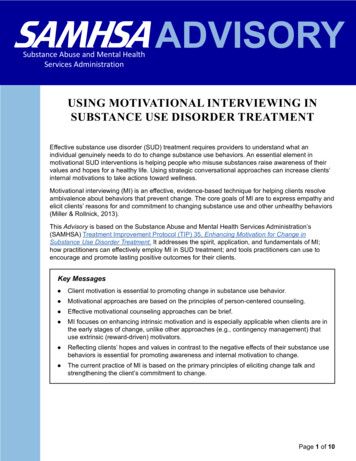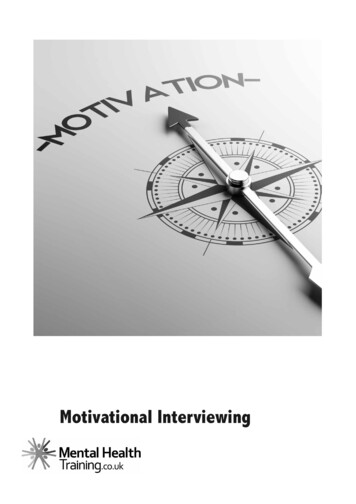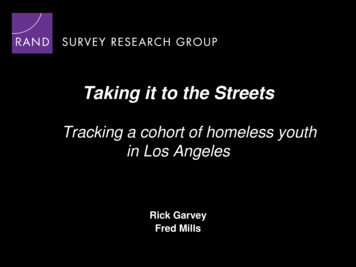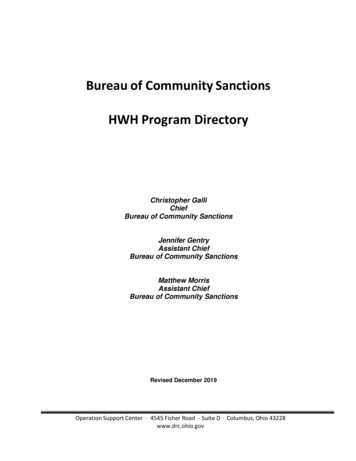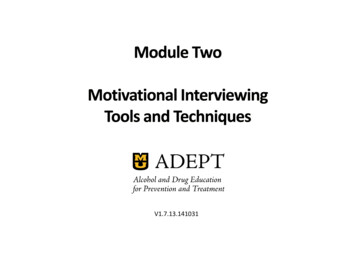
Transcription
Introduction toStages of Changeand Change Talk inMotivationalInterviewingLisa Kugler, PsyD.
Goals for Today’s Seminar Participants will be able to identify 3 key elementsof motivational interviewing Participants will be able to define stages ofchange and discuss how this guides interactions Participants will be able to identify change talkand utilize means to encourage it2
Background- Stages of Change During his college years, psychologist James Prochaska, Ph.D., losthis father to alcoholism and depression. Prochaska discussed hisfather’s mistrust in psychotherapy and his refusal to participate incounseling. Because of James’ personal experiences, James hasfocused his research into substance abuse and the stages ofchange. Prochaska and DiClemente started their research by observingindividuals who had over come nicotine addictions. Theydiscovered change occurred on a continuum and identifiedcommon stages that most individuals progressed through.Prochaska and DiClemente developed a model of therapy basedupon these stages.3
Stages of Change This model provides practitioners with a way inwhich to understand how clients change, as wellas what motivates them to change.4
Stages of Change Prochaska and DiClemente argue that behaviorchange cannot be thought of as a specific eventoccurring at a specific point in time. Rather,change should be thought of as a process thatmay take months or even years.5
Motivation The actual skills that are used in each therapysession are determined by an individual’smotivational state.6
Stages of Change Precontemplation Contemplation Preparation (previously determination) Action Maintenance Relapse7
Stages of Change It is important to note that the change process is cyclical, andindividuals typically move back and forth between the stages andcycle through the stages at different rates. In one individual, thismovement through the stages can vary in relation to differentbehaviors or objectives. In some situations, individuals can movethrough stages quickly. Sometimes, they move so rapidly that it isdifficult to pinpoint where they are because change is a dynamicprocess. It is not uncommon, however, for individuals to linger,especially in the early stages. In general, precontemplation and contemplation take substantialamounts of time. Contemplation is generally very uncomfortable. id hstat5.section.616268
For any behavioral problem at a given time, there are (inthe population at large): 40% in precontemplation 40% in contemplation 20% in preparation or action Prochaska and DiClemente, 19989
PrecontemplationAdapted from: The National Center for Biotechnology Information: TIP 35: Enhancing Motivation for Change inSubstance Abuse Treatment: http://www.ncbi.nlm.nih.gov/books/bv.fcgi?rid hstat5.chapter.61302Taken from Integrating Motivational Interviewing, the Stages of Change Model and Treatment Planning, Gavin andHoffman10
ContemplationAdapted from: The National Center for Biotechnology Information: TIP 35: Enhancing Motivation for Change inSubstance Abuse Treatment: http://www.ncbi.nlm.nih.gov/books/bv.fcgi?rid hstat5.chapter.61302Taken from Integrating Motivational Interviewing, the Stages of Change Model and Treatment Planning, Gavin andHoffman11
PreparationAdapted from: The National Center for Biotechnology Information: TIP 35: Enhancing Motivation for Change inSubstance Abuse Treatment: http://www.ncbi.nlm.nih.gov/books/bv.fcgi?rid hstat5.chapter.61302Taken from Integrating Motivational Interviewing, the Stages of Change Model and Treatment Planning, Gavin andHoffman12
ActionTaken from Integrating Motivational Interviewing, the Stages of Change Model and Treatment Planning, Gavinand Hoffman13
MaintenanceAdapted from: The National Center for Biotechnology Information: TIP 35: Enhancing Motivation for Change in SubstanceAbuse Treatment: http://www.ncbi.nlm.nih.gov/books/bv.fcgi?rid hstat5.chapter.61302Taken from Integrating Motivational Interviewing, the Stages of Change Model and Treatment Planning, Gavin andHoffman14
Vignette What stage of change would you guess? Maria wonders if all this stuff about how caffeine can hurtyour baby is true. She has been drinking 5 cups of coffee aday for as long as she can remember, and it hasn’t seemedto do anything to her before. Still she hasn’t been able tosleep since she became pregnant and now her stomachgets upset after even one cup of coffee. She saw babies atthe hospital that were really tiny, and the doctors says it’sdue to caffeine. Maybe I should consider cutting down alittle,” she thinks.15
In essence we are moving from this 16
To this .17
So what does this have to do with MotivationalInterviewing? Motivation plays an important role in people’sdecision to change or remain the same. Motivational interviewing raises an individual’sconsciousness about their own motivations andallows the member to make an informeddecision.18
Motivational Interviewing Basics Motivation is a state of readiness to change, which mayfluctuate from minute to minute and situation to situation.For yourself, think about something you wanted to changeand how this motivation fluctuated throughout the day. Thisstate can be influenced by environment, people, emotionalstate, and things. Motivation for change does not reside solely within theclient. People struggling with behavioral problems often haveconflicting motivations for change (stay the same orchange), also known as ambivalence. Ambivalence is anormal part of the change process and is NOT pathological19
Motivational Interviewing Basics The counselor’s style is a powerful determinant ofclient’s actions and reactions. An empathic styleis more likely to bring out self-motivationalresponses and will reduce resistance from theclient Each person has powerful potential for change.The task of the counselor is to release thatpotential and facilitate the natural changeprocess that is already inherent in the individual.20
Motivational Interviewing Building BlocksAs an outline, Rollinick described his RULE R- Resist the righting reflex U- Understand your client’s motivation L-Listen to your client E- Empower your client Taken from Building Motivational Interviewing SkillsRosengren, 200921
Motivational Interviewing R- Resist the righting reflex: This is the tendency to actively FIX problems intheir client’s lives which actually reduces the likelihood of client change.Examples include arguing with a client, telling clients how to change, tryingto convince a client of something, warning the clients of the consequencesof not changing U- Understanding your client’s motivation: Motivational interviewing takesthe stance that motivation comes from within the client. That is we do notmotivate clients or install motivation in them, rather we help them find theirown motivation L- Listen to your client: The basis of motivational interviewing is reflectivelistening and an attitude of acceptance of the client’s feelings andperspectives. Try to understand the client’s perception, this does not meanthat you agree with it. E- Empower your client: Ultimately the change must come from the client.Support the client’s beliefs that they are capable of change andencourage a “can do” attitude.22
Example- How NOT to do Motivational Interviewing https://www.youtube.com/watch?v kN7T-cmb l023
How is this Done? Through the OARS Open ended questions Affirmations Reflections Summaries24
When do you use the OARS in stages of change? The OARS can be utilized in all stages of changebut are most useful in pre-contemplation andcontemplation stage of change. The OARS represent the spirit of MotivationalInterviewing25
Reflections are MOST important skills learned in MI Reflective listening is key to accurate empathy. Reflective listening is a fundamental skill tomotivational interviewing. Reflective listening can be used by a clinician todetermine if the clinician is moving ahead of themember which can create resistance.26
Different Kinds of Reflective Listening Paraphrasing: Therapist makes a guess at theunspoken meaning and reflects this back in newwords. This is also known as a complex reflection Reflection of feeling: Paraphrase the content ofwhat the client stated which emphasizes theemotional content of the consumer’s statement.(Not an interpretation.)27
Different Kinds of Reflective Statements Simple reflection- stays very close to what theclient said: Client: I don’t have anything to say. Counselor: You are not feeling like talking today. Amplified Reflection- Pushes on an absolutestatement: Client: I won’t take my medications because itwould be such a hassle. Counselor: Taking your medications interferes witheverything in your life.28
Different Kinds of Reflective Statements Complex Reflection: Goes well beyond what theperson has said and may not use the same words,often cognitively reframes the material, infersgreater meaning and may include affect. Client: But I can't quit using. I mean, all of myfriends use! Counselor: There is a fear that if you stop using youwill be all alone.29
More Reflective Statements Double – sided reflection: Client: I think I would feel so much better aboutmyself if I were in better shape, but it’s so hard tostick to a workout plan. Counselor: On the one hand, trying to work outconsistently is challenging, and at the same time,you think your self-esteem would improve if you lostweight.30
Reflective Statements- Example https://www.youtube.com/watch?v SZ-IH-V7oJ4 Exercise to Practice OARS- Batting Practice31
These skills are used to try to elicit change talk Change talk are the JEWELS of therapy!32
Change Talk Change talk can be found at any stage ofchange but is most prevalent at contemplation,preparation, and action.33
Change Talk! Change talk is made up of four elements: Change talk represents statements about change.Basically speaking, these are client statementsindicate that they have the desire or ability tochange, see the benefits of change, observe thedifficulties of their current situation, are committedto change or are taking steps to change. Change talk is linked to a specific behavior or setof behaviors. Change talk is linked to a goal.34
Change Talk! Change talk typically comes from the client, notthe clinician, but it does not have to come fromthe client. Change talk is typically phrased in the presenttense.35
Change Talk Change talk is measured by DARNs Desire: Desire to Change Ability: Ability to Change Reasons: Reasons for Change Need: Need to Change or Problems with StatusQuo36
Ways to Elicit Change TalkAsk for Elaboration – especially as change talkemerges – ask for more detail: How, specifically, has impacted yourhealth? (life/family/leisure?) In what ways have you thought of changing? Tell me what you dreamed of doing instead37
Ways to Elicit Change TalkExploring Goals What things do you see as most important? What sort of person do you want to be? In what ways will this assist in reaching yourgoals?38
Ways to Elicit Change TalkLooking Back Do you remember a time when things weregoing well? What has changed? What are the differences between the you of 10years ago and the you of today? What did you envision for your life when youwere young?39
Ways to Elicit Change TalkLooking Forward If nothing changes, what do you see happeningin 5 years from now? If you decide to change,what will it be like? What are your hopes for the near future? How would you like things to be different?40
Ways to Elicit Change TalkEvocative Questions In what ways does this concern you?If you decided to make a change, what makesyou think you could do it? How would you like things to be different? How would things be better if you changed?41
Ways to Elicit Change TalkElaboration Tell me about a recent time when XXXXhappened- tell me more about it. You said things were better then, tell me aboutit 42
Ways to Elicit Change TalkUsing Extremes So it does not concern you at all. What concerns you the most? What is the worst things that could happen? What would a perfect outcome look like?43
Readiness Rulers Readiness to change is measured by 3 items Willing: The importance of change Able: Confidence for change Ready: A matter of priorities44
Readiness Rulers Willing: The importance of change How willing are you to change at this time? On a scale of 1-10 how willing are you to change and why? What would you need to get you from the number you are to onenumber higher? Why aren’t you one number lower? Able: Confidence for change How able are you to change at this time? On a scale of 1-10 how able are you to change and why? What would you need to get from where you are now to onenumber higher? Why aren’t you one number lower?45
Readiness Rulers Ready: A matter of priorities How willing are you to change at this time? On a scale of 1-10 how willing are you to change andwhy? What would you need to get you from the numberyou are to one number higher? Why aren’t you one number lower? Can use Readiness Rulers (Likert scales) to assessreadiness and perceived abilities to change. This can increase change talk46
What does this Look like in Therapy?https://www.youtube.com/watch?v U32rGyGrd9047
Other than therapy? Is there any place for the skills utilized inmotivational interviewing and the spirit ofmotivational interviewing in the workplace?48
References DiClemente, C.C. (1991). Motivational interviewing and the stages of change. InW.R. Miller & S. Rollnick (Eds.) Motivational interviewing: Preparing people tochange addictive behavior . New York: Guilford Press. Rosengren, D. (2009). Building Motivational Interviewing Skills, New York: GuilfordPress. TIP 35: Enhancing Motivation for Change in Substance Abuse i?rid hstat5.chapter.61302 Velasquez, M., Maurer, G., Crouch, C., DiClemente, C. (2001). Group Treatment forSubstance Abuse, New York: Guilford Press. Glavin, K., Hoffman, R. Integrating Motivational Interviewing, the Stages of ChangeModel, and Treatment Planning (power point) All-Ohio Counselors ConferenceNovember 2-4, 2005.49
Questions?50
Motivational Interviewing Basics 19 Motivation is a state of readiness to change, which may fl


